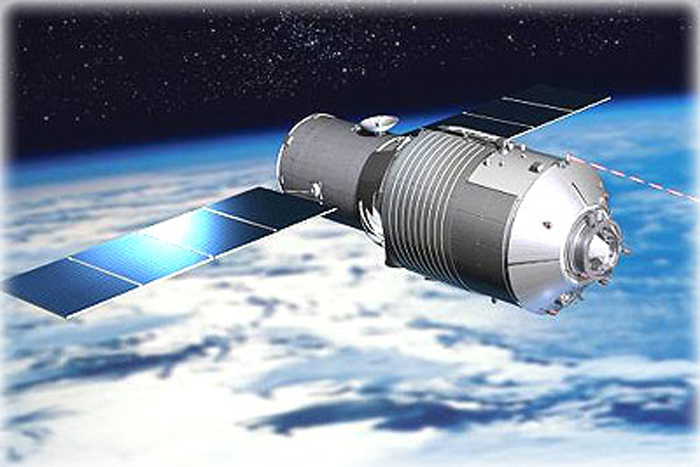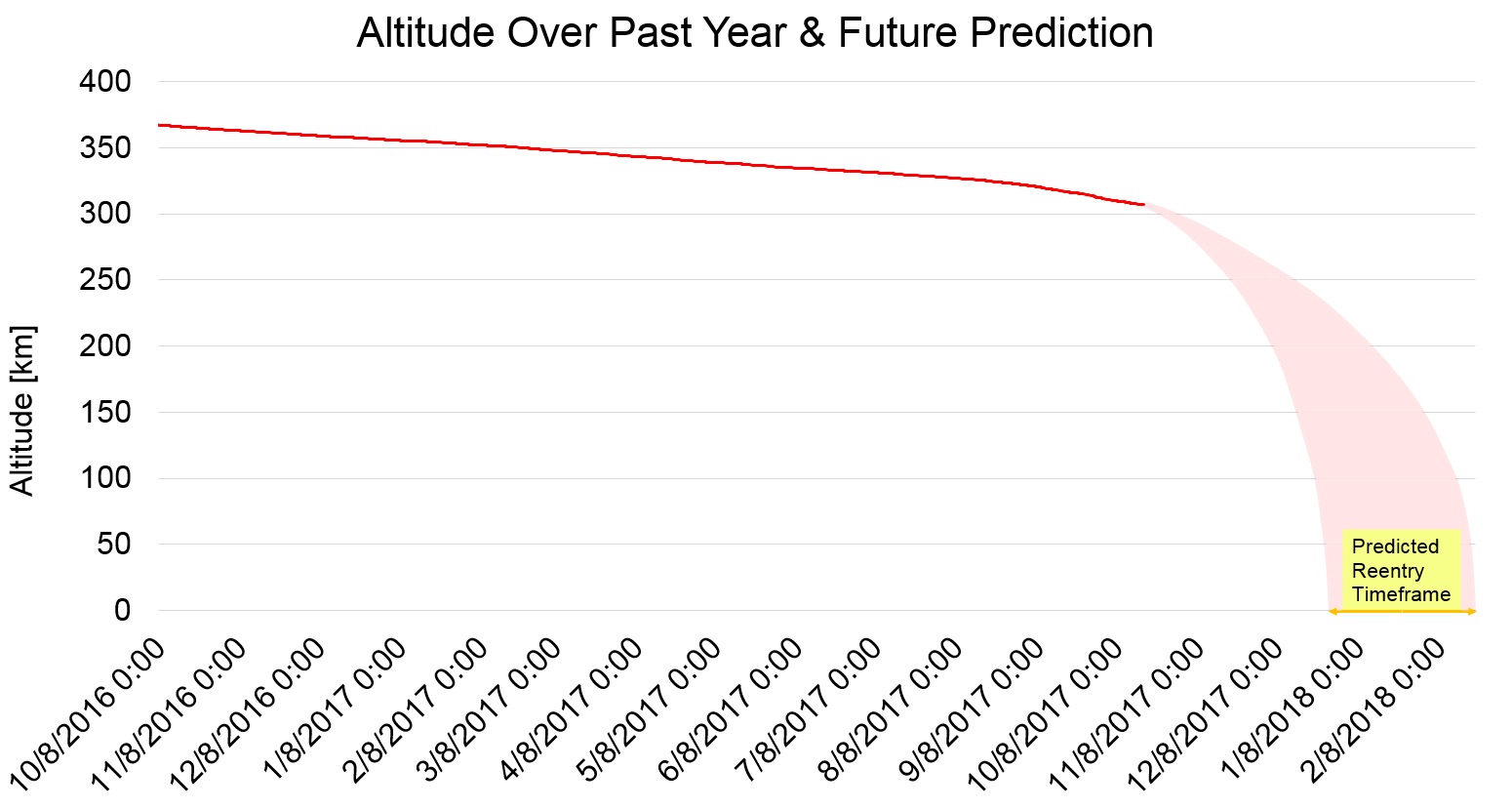
China's Fall Guy: Tiangong-1 Space Lab to Crash in Early 2018

China's Tiangong-1 space lab is headed for an uncontrolled and destructive nose-dive into Earth's atmosphere early next year.
Exactly when and where on Earth the multiton discarded craft will make its plunge cannot now be predicted. All that's known is that the vehicle will re-enter somewhere between 43 degrees north and 43 degrees south latitudes.
Tiangong-1 (whose name means "Heavenly Palace" in Chinese) was rocketed into Earth orbit in late September 2011. It was used for six successive rendezvous and dockings with other spacecraft — Shenzhou-8 (uncrewed), Shenzhou-9 (piloted) and Shenzhou-10 (piloted) — as part of China's human space exploration activities. The vehicle weighed 18,740 lbs. (8,500 kilograms) at launch. [Gallery: Tiangong 1, China's First Space Laboratory]
The space lab ceased functioning in March 2016, and to date the Tiangong-1 has maintained its structural integrity. The vehicle is 34 feet (10.5 meters) long and sports a diameter of 11 feet (3.4 m). The lab has two solar panels, which measure approximately 23 feet (7 m) by 10 feet (3 m).
Dropping in altitude
A check of orbital data shows that Tiangong-1 has been slowly dropping in altitude, from roughly 225 miles (360 kilometers) at the beginning of 2017 to about 193 miles (310 km) at present, said T.S. Kelso, a senior research astrodynamicist at the Center for Space Standards & Innovation (CSSI), a research arm of Analytical Graphics.
Analysis of two-line element (TLE) data, a format for distributing spacecraft orbital data, suggests that "we would expect to see re-entry occur somewhere around the last week of March 2018," Kelso told Inside Outer Space.
Notification
Earlier this year, the United Nations Office for Outer Space Affairs (UNOOSA) reissued a notification by China on Tiangong-1's future uncontrolled re-entry.
Get the Space.com Newsletter
Breaking space news, the latest updates on rocket launches, skywatching events and more!
"The probability of endangering and causing damage to aviation and ground activities is very low," the notification states.
The notice advises that China attaches great importance to the re-entry of Tiangong-1 and will take the following measures regarding monitoring its fall and providing public information:
— China will enhance monitoring and forecasting, make strict arrangements to track Tiangong-1 and publish a timely forecast of the craft's re-entry.
— China will make use of the international joint monitoring information under the framework of the Inter-Agency Space Debris Coordination Committee, in order to be better informed about the descent of Tiangong-1.
— China will improve information-reporting mechanisms. Dynamic orbital status and other information relating to Tiangong-1 will be posted on the website of the China Manned Space Agency in both Chinese and English. In addition, timely information about important milestones and events during the orbital decay phases will be released through the news media.
— As to the final forecast of the time and region of re-entry, China will issue the relevant information and early warning in a timely manner and bring it to the attention of UNOOSA and the U.N. Secretary-General by means of "note verbale" through diplomatic channels. [Latest News About China's Space Program]
Leftovers
According to The Aerospace Corp.'s Center for Orbital and Reentry Debris Studies (CORDS), based on Tiangong-1's inclination, the lab will re-enter somewhere between 43 degrees north and 43 degrees south latitudes.
Modeling work performed by The Aerospace Corp. on Oct. 18, 2017, shows Tiangong-1 re-entering in late January 2018, plus or minus 1 month.
That's a little earlier than Kelso's modeling work predicts, but it's not surprising that the two estimates differ.
"The variability in the estimate is a result of our current limited understanding of how atmospheric drag affects an orbit — some of that is based on characteristics of the satellite, including its attitude, which is probably tumbling — and limited ability to forecast the state of the atmosphere," Kelso said.
As for lingering leftovers, the CORDS website states that "it is highly unlikely that debris from this re-entry will strike any person or significantly damage any property," adding: "Potentially, there may be a highly toxic and corrosive substance called hydrazine on board the spacecraft that could survive re-entry. For your safety, do not touch any debris you may find on the ground nor inhale vapors it may emit."
The Aerospace Corp. will perform a person and property risk calculation for the Tiangong-1 re-entry a few weeks before the event, company representatives said.

Re-entry viewing
According to CORDS, it may be possible to see Tiangong-1 re-entering depending on the viewer's location, the time of day, and visibility during re-entry, which will not be known until a few days before the event.
A more detailed predicted re-entry region will be provided a few days before the re-entry time frame. Visibly incandescent objects from this re-entry will likely last tens of seconds (up to a minute or more), in contrast with the vast majority of natural meteors, which last mere seconds.
CORDS also notes that, depending on the time of day and cloud visibility, the re-entry may appear as multiple bright streaks moving across the sky in the same direction. Due to the relatively large size of the object, it is expected that there will be many pieces re-entering together, some of which may survive re-entry and land on the Earth's surface.
Resources
Check out this video taken by the European Space Agency (ESA) from an observation aircraft showing the ESA Automated Transfer Vehicle (ATV-1) spacecraft re-entering over the Pacific Ocean after completing its ISS resupply mission.
You can also read a story of mine from June 2016, titled "China's 'Heavenly Palace': Headed for a Hellish Demise?"
Leonard David is author of "Mars: Our Future on the Red Planet," published by National Geographic. The book is a companion to the National Geographic Channel series "Mars." A longtime writer for Space.com, David has been reporting on the space industry for more than five decades. Follow us @Spacedotcom, Facebook or Google+. This version of this story was posted on Space.com.
Join our Space Forums to keep talking space on the latest missions, night sky and more! And if you have a news tip, correction or comment, let us know at: community@space.com.

Leonard David is an award-winning space journalist who has been reporting on space activities for more than 50 years. Currently writing as Space.com's Space Insider Columnist among his other projects, Leonard has authored numerous books on space exploration, Mars missions and more, with his latest being "Moon Rush: The New Space Race" published in 2019 by National Geographic. He also wrote "Mars: Our Future on the Red Planet" released in 2016 by National Geographic. Leonard has served as a correspondent for SpaceNews, Scientific American and Aerospace America for the AIAA. He has received many awards, including the first Ordway Award for Sustained Excellence in Spaceflight History in 2015 at the AAS Wernher von Braun Memorial Symposium. You can find out Leonard's latest project at his website and on Twitter.









